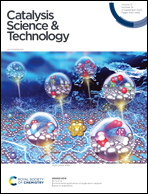Theoretical study on dry reforming of methane over a Ni(111) surface under electric fields and with alkali metal additives†
Abstract
The dry reforming of methane (DRM) reaction is an effective way to convert greenhouse gases into syngas and mitigate the greenhouse effect. However, Ni-based catalysts tend to deposit carbon and reduce catalytic activity due to the high endothermic properties of the DRM reaction. Nickel catalysts promote the DRM reaction and exhibit good catalytic activity and resistance to carbon deposition by applying external electric fields. The DRM reaction on a Ni(111) surface under electric fields of +0.6, 0, and −0.6 V Å−1 and with the K additive was systematically studied by density functional theory calculation and microkinetic modeling in this work. The results showed that electric fields can adjust the adsorption strength of species. Notably, exposed negative electric fields and alkali metals can promote the adsorption strength of oxygen-containing species by increasing the electron-donating ability and thus reducing the CO2 activation energy. The path of CH–O oxidation on all Ni-based catalysts was the most favorable in the DRM reaction, and the free energy span was K/Ni(111) < Ni(111) (−0.6 V Å−1) < Ni(111) (+0.6 V Å−1) < Ni(111), indicating that the applied electric field (or alkali metal) is conducive to the elimination of surface carbon species. The effect of alkali metals to improve the activity and resistance to carbon deposition of Ni-based catalysts by promoting CO2 dissociation can be quantitatively reproduced by external negative electric fields. The degree of rate control analysis showed that the activation of CH4 and CO2 had a crucial impact on the formation rate and carbon deposition of the DRM reaction. Microkinetic modeling results showed that conversions of CH4 and CO2 were increased under a positive electric field. The carbon deposition resistance was in the order of Ni(111) (+0.6 V Å−1) < Ni(111) < Ni(111) (−0.6 V Å−1) < K/Ni(111). Moreover, the H2/CO ratio was smaller than the unit under a negative electric field and an alkali additive due to the facile dissociation of CO2, whereas it was close to the unit under a positive electric field. Our theoretical results correspond well with experimental observations that the application of electric fields and the K additive can not only improve the catalytic activity of Ni-based catalysts but also enhance the carbon deposition resistance. This work provided an understanding of how the electric field and K additive can help eliminate carbon deposition at the atomic level.



 Please wait while we load your content...
Please wait while we load your content...